Andrea Büttner
Gesamtzusammenhang
04 Mar - 07 May 2017
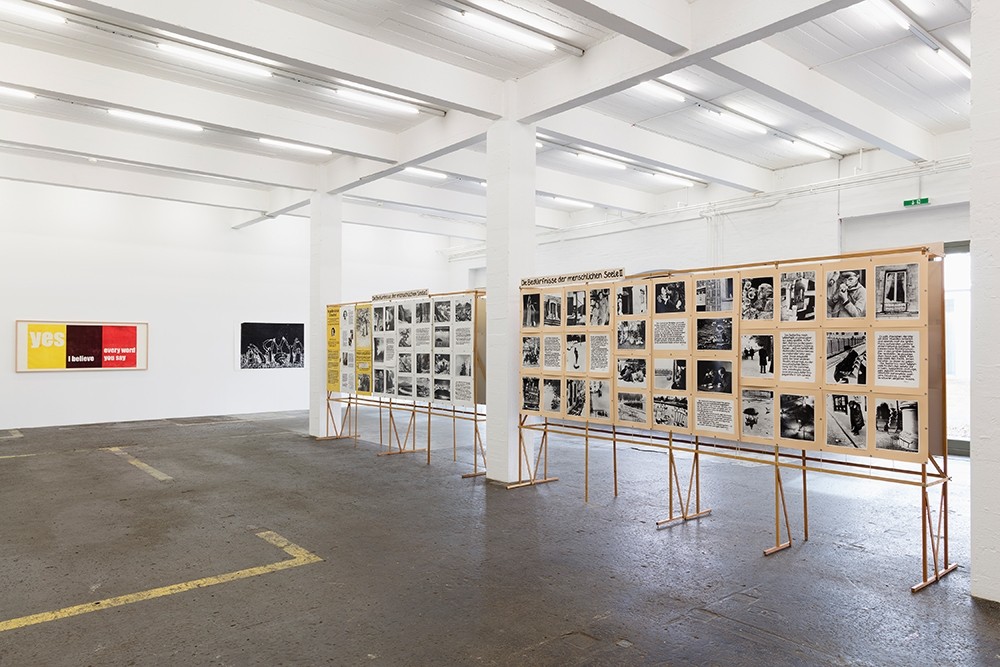
Exhibition view, Andrea Büttner, Yes, I believe every word you say, 2007;
Dancing Nuns, 2007; exhibition of the Friedensbibliothek/
Antikriegsmuseum Berlin about Simone Weil
Courtesy Andrea Büttner: the artist; Hollybush Gardens, London;
David Kordansky Gallery, Los Angeles; Galerie Tschudi, Zuoz
Photo: Kunst Halle Sankt Gallen, Gunnar Meier
Dancing Nuns, 2007; exhibition of the Friedensbibliothek/
Antikriegsmuseum Berlin about Simone Weil
Courtesy Andrea Büttner: the artist; Hollybush Gardens, London;
David Kordansky Gallery, Los Angeles; Galerie Tschudi, Zuoz
Photo: Kunst Halle Sankt Gallen, Gunnar Meier

Andrea Büttner, exhibition view, Yes, I believe every word you say, 2007; Dancing Nuns, 2007; Bush, 2010
Courtesy: the artist; Hollybush Gardens, London;
David Kordansky Gallery, Los Angeles; Galerie Tschudi, Zuoz
Photo: Kunst Halle Sankt Gallen, Gunnar Meier
Courtesy: the artist; Hollybush Gardens, London;
David Kordansky Gallery, Los Angeles; Galerie Tschudi, Zuoz
Photo: Kunst Halle Sankt Gallen, Gunnar Meier
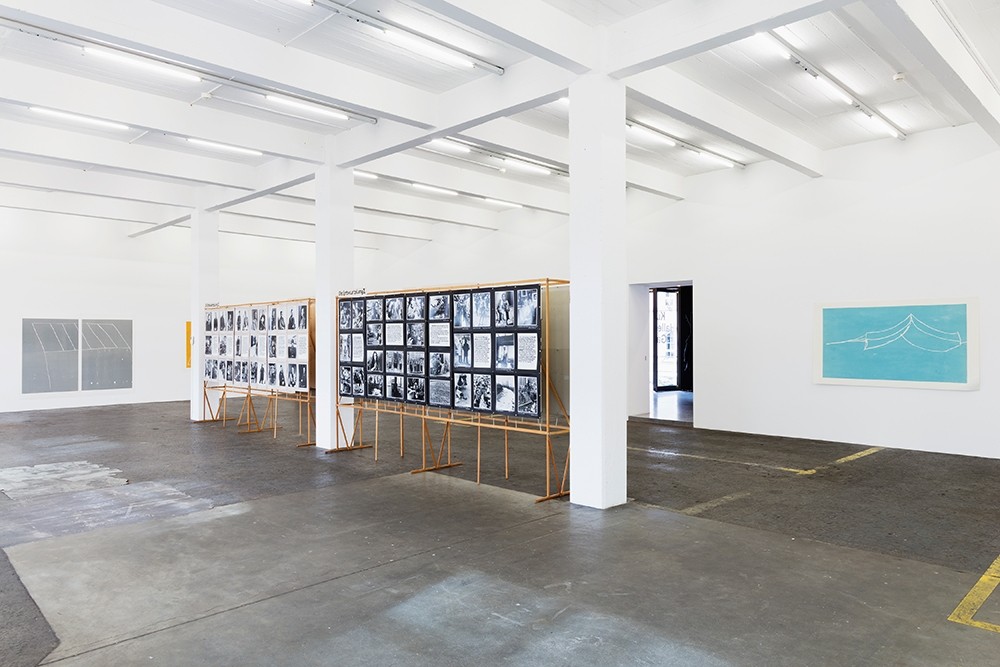
Exhibition view, Andrea Büttner, Tent (marquee), 2012;
exhibition of the Friedensbibliothek/Antikriegsmuseum Berlin
about Simone Weil; Andrea Büttner, Blue Tent, 2010
Courtesy Andrea Büttner: the artist; Hollybush Gardens, London;
David Kordansky Gallery, Los Angeles; Galerie Tschudi, Zuoz
Photo: Kunst Halle Sankt Gallen, Gunnar Meier
exhibition of the Friedensbibliothek/Antikriegsmuseum Berlin
about Simone Weil; Andrea Büttner, Blue Tent, 2010
Courtesy Andrea Büttner: the artist; Hollybush Gardens, London;
David Kordansky Gallery, Los Angeles; Galerie Tschudi, Zuoz
Photo: Kunst Halle Sankt Gallen, Gunnar Meier
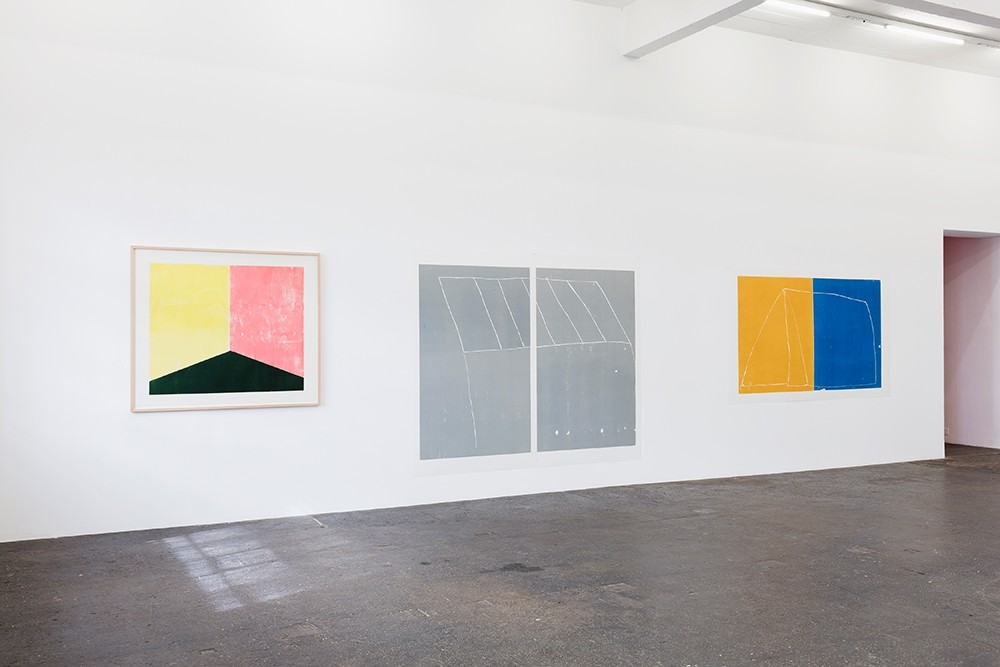
Andrea Büttner, exhibition view, Corner, 2011-12;
Tent (marquee), 2012; Tent (two colours), 2012-13
Courtesy: the artist; Hollybush Gardens, London;
David Kordansky Gallery, Los Angeles; Galerie Tschudi, Zuoz
Photo: Kunst Halle Sankt Gallen, Gunnar Meier
Tent (marquee), 2012; Tent (two colours), 2012-13
Courtesy: the artist; Hollybush Gardens, London;
David Kordansky Gallery, Los Angeles; Galerie Tschudi, Zuoz
Photo: Kunst Halle Sankt Gallen, Gunnar Meier

Exhibition view, Andrea Büttner, Tent (marquee), 2012;
Tent (two colours), 2012-13; Duck and Daisy, 2015; Sky, 2015;
exhibition of the Friedensbibliothek/Antikriegsmuseum Berlin
about Simone Weil
Courtesy Andrea Büttner: the artist; Hollybush Gardens, London;
David Kordansky Gallery, Los Angeles; Galerie Tschudi, Zuoz
Photo: Kunst Halle Sankt Gallen, Gunnar Meier
Tent (two colours), 2012-13; Duck and Daisy, 2015; Sky, 2015;
exhibition of the Friedensbibliothek/Antikriegsmuseum Berlin
about Simone Weil
Courtesy Andrea Büttner: the artist; Hollybush Gardens, London;
David Kordansky Gallery, Los Angeles; Galerie Tschudi, Zuoz
Photo: Kunst Halle Sankt Gallen, Gunnar Meier
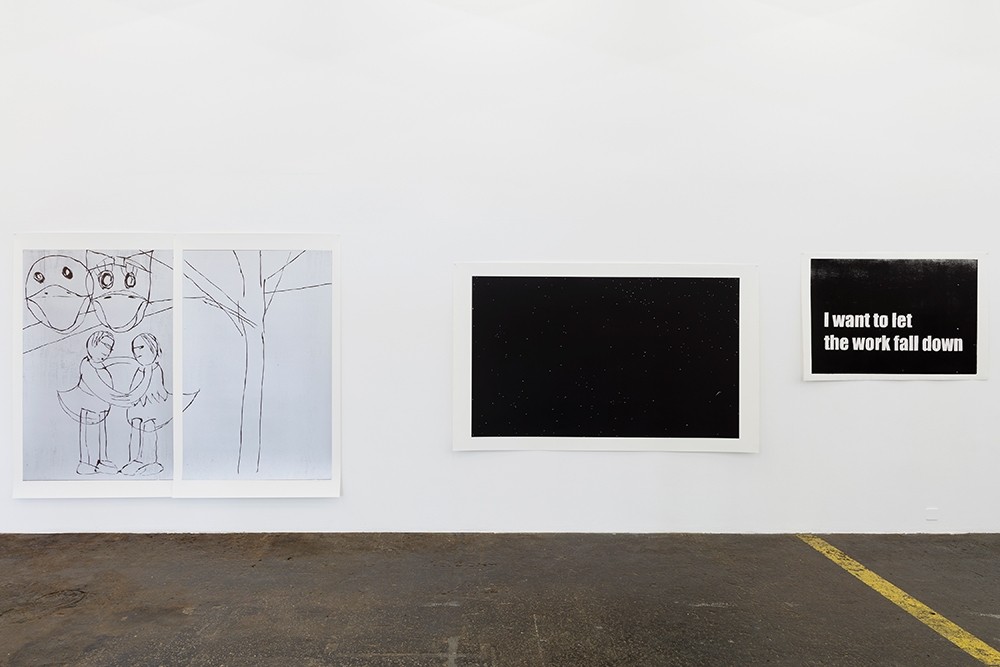
Andrea Büttner, exhibition view, Duck and Daisy, 2015;
Sky, 2015; I want to let the work fall down, 2005
Courtesy: the artist; Hollybush Gardens, London;
David Kordansky Gallery, Los Angeles; Galerie Tschudi, Zuoz
Photo: Kunst Halle Sankt Gallen, Gunnar Meier
Sky, 2015; I want to let the work fall down, 2005
Courtesy: the artist; Hollybush Gardens, London;
David Kordansky Gallery, Los Angeles; Galerie Tschudi, Zuoz
Photo: Kunst Halle Sankt Gallen, Gunnar Meier
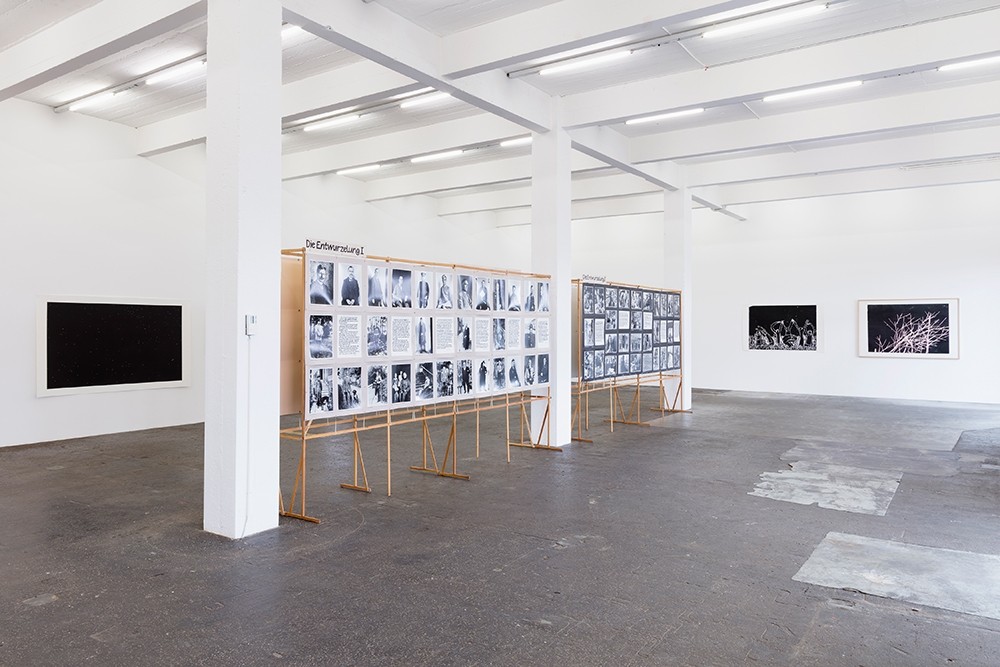
Exhibition view, Andrea Büttner, Sky, 2015;
exhibition of the Friedensbibliothek/Antikriegsmuseum Berlin
about Simone Weil; Andrea Büttner, Dancing Nuns, 2007; Bush, 2010
Courtesy Andrea Büttner: the artist; Hollybush Gardens, London;
David Kordansky Gallery, Los Angeles; Galerie Tschudi, Zuoz
Photo: Kunst Halle Sankt Gallen, Gunnar Meier
exhibition of the Friedensbibliothek/Antikriegsmuseum Berlin
about Simone Weil; Andrea Büttner, Dancing Nuns, 2007; Bush, 2010
Courtesy Andrea Büttner: the artist; Hollybush Gardens, London;
David Kordansky Gallery, Los Angeles; Galerie Tschudi, Zuoz
Photo: Kunst Halle Sankt Gallen, Gunnar Meier

Andrea Büttner, exhibition view, Tent (two colours), 2012-13;
Fabric Painting, 2017; Bench, 2012; Duck and Daisy, 2015
Courtesy: the artist; Hollybush Gardens, London;
David Kordansky Gallery, Los Angeles; Galerie Tschudi, Zuoz
Photo: Kunst Halle Sankt Gallen, Gunnar Meier
Fabric Painting, 2017; Bench, 2012; Duck and Daisy, 2015
Courtesy: the artist; Hollybush Gardens, London;
David Kordansky Gallery, Los Angeles; Galerie Tschudi, Zuoz
Photo: Kunst Halle Sankt Gallen, Gunnar Meier
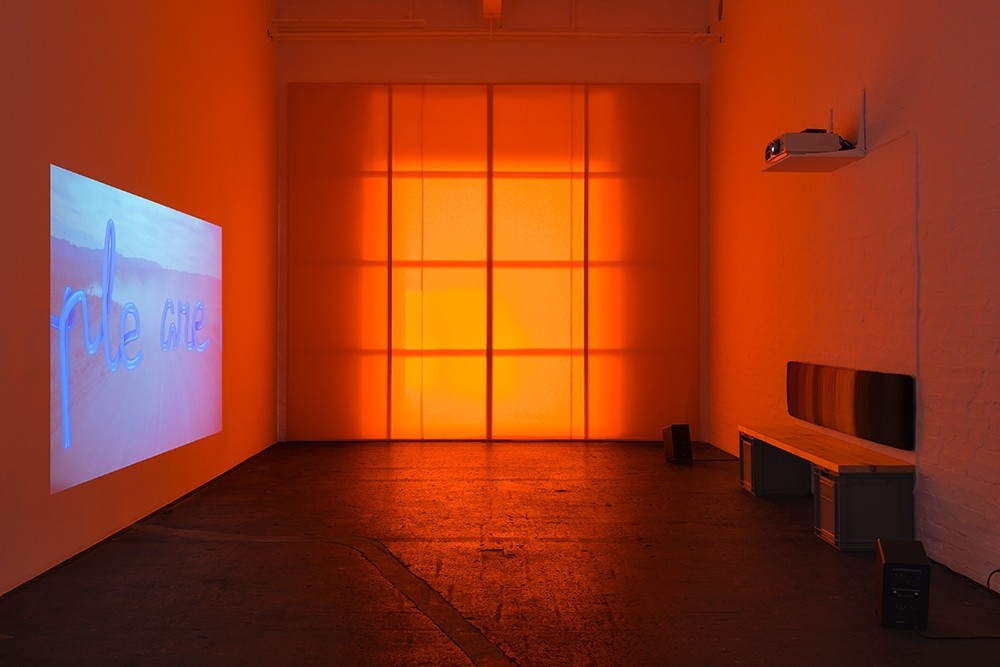
Exhibition view, David Raymond Conroy, (You (People) Are All
The Same), 2016; Andrea Büttner, Fabric Painting, 2017; Bench, 2012
Courtesy David Raymond Conroy: the artist; Seventeen Gallery, London
Courtesy Andrea Büttner: the artist; Hollybush Gardens, London;
David Kordansky Gallery, Los Angeles; Galerie Tschudi, Zuoz
Photo: Kunst Halle Sankt Gallen, Gunnar Meier
The Same), 2016; Andrea Büttner, Fabric Painting, 2017; Bench, 2012
Courtesy David Raymond Conroy: the artist; Seventeen Gallery, London
Courtesy Andrea Büttner: the artist; Hollybush Gardens, London;
David Kordansky Gallery, Los Angeles; Galerie Tschudi, Zuoz
Photo: Kunst Halle Sankt Gallen, Gunnar Meier

Exhibition view, Andrea Büttner, Tent (igloo), 2012;
David Raymond Conroy, (You (People) Are All The Same), 2016;
Andrea Büttner, Fabric Painting, 2017; Bench, 2012
Courtesy David Raymond Conroy: the artist; Seventeen Gallery, London
Courtesy Andrea Büttner: the artist; Hollybush Gardens, London;
David Kordansky Gallery, Los Angeles; Galerie Tschudi, Zuoz
Photo: Kunst Halle Sankt Gallen, Gunnar Meier
David Raymond Conroy, (You (People) Are All The Same), 2016;
Andrea Büttner, Fabric Painting, 2017; Bench, 2012
Courtesy David Raymond Conroy: the artist; Seventeen Gallery, London
Courtesy Andrea Büttner: the artist; Hollybush Gardens, London;
David Kordansky Gallery, Los Angeles; Galerie Tschudi, Zuoz
Photo: Kunst Halle Sankt Gallen, Gunnar Meier
Andrea Büttner with David Raymond Conroy and Friedensbibliothek/Antikriegsmuseum Berlin
Andrea Büttner’s artistic practice is multifaceted and creates an area of tension between ethics and aesthetics, and subjectivity and culture. Büttner deals with themes such as the attribution of value, poverty and shame, using various media including woodcuts, sculptures, textile works and video installations. For her first exhibition at a Swiss institution Büttner is focussing on woodcuts from various series and setting them in a new context: on the one hand her works appear in relation to an exhibition about Simone Weil by the Friedensbibliothek/Antikriegsmuseum in Berlin-Brandenburg (Peace Library/Anti-War Museum of the Protestant Church in Berlin-Brandenburg) and on the other, David Raymond Conroy’s video (You (People) Are All The Same) augments the contextual range. «Gesamtzusammenhang» («Bigger Picture») brings together artistic and non-artistic questions which encompass humanity in connection with work, community and belief.
Andrea Büttner is interested in moments of transition, as shown by the religiously and symbolically charged motifs of the woodcuts on view in each room. Subjects such as dancing nuns, tents, beggars and sentences like 'Yes, I believe every word you say’ challenge contemporary expectations, as does the medium of the woodcut. This centuries-old technique communicates simply and directly but retains an artistic and decelerating aura of the process of its making. A characteristic that is shared by the exhibition wall of the Friedensbibliothek/Antikriegsmuseum, all be it from a non-artistic perspective. Hand-written quotes from the work of the French philosopher Simone Weil (1909 - 1943) hang on an elaborate construction, partly developed back in the time of the GDR, with illustrations by various photographers.
The integrated exhibition from the Friedensbibliothek/Antikriegsmuseum poses questions about the efficiency of messages and their display. Büttner thereby also examines her own art in direct confrontation with aesthetic practices which are both close to and different from her own. The woodcuts and the Simone Weil presentation enter into a reciprocal survey of dividing lines between handwork and art, spiritual experience and contemplation.
The juxtaposition of the two displays is evident in view of Büttner’s artistic practice. Her installative works were created in the context of the early 1990s. Postmodern art discourse such as post-conceptualism and institutional critique attempted to renegotiate the interface between politics and art and pursue a media-based vocabulary but spawned a very normative and mostly male aesthetic. Büttner wants to break with this reception and apply methods that extract a certain sexiness.
The Friedenbibliothek/Antikriegsmuseum was also searching for its own form of expression. Founded in the GDR under the auspices of the Protestant Church in Berlin-Brandenburg, the Friedenbibliothek/Antikriegsmuseum with its mobile exhibitions, subtle critiques of the regime and social networking was part of a resistance movement. Jochen Schmidt, who was part of the team responsible, says that the political changes in Germany brought a feeling of rootlessness. A system, which so many thought could not be brought down, collapsed overnight. At this time Schmidt and his colleagues discovered Simone Weil, a Jewish philosopher whose thought is coloured both by socialism and mystical Christianity. The exhibition on show here is primarily concerned with her posthumously published work The Need for Roots, in which she goes into ‘the most important and least recognised need of the human soul’ as well as ‘uprootedness’ and ‘the growing of roots’.
Büttner has been concerned with Simone Weil for a long time, especially because Weil also addressed philosophical, political and religious questions. With the help of this borrowed exhibition Büttner can import Weil into her work without having to participate in the current notable appropriation of the philosopher. Büttner is interested in Weil’s ideas and her fragmented, historically complex life. The artist is similarly fascinated by monastic activism in France during the 1930s and 1940s and the lifestyle concepts of nuns between religion and politics.
For example, for dOCUMENTA (13) Büttner produced a film about nuns in a religious order who operate a stall at an amusement park in Rome and formulated a theory of smallness, humility, reserve and simplicity. From this work came the Tent Series from which various exhibits are on show. Her dynamic composition of seven dancing figures as a symbol of a positive space is also concerned with nuns. On the other hand, I want to let the work fall down (2005) and Yes, I believe every word you say (2007) are reminiscent of the pop art works of the activist nun Corita Kent. Bush (2010) comes from the cycle about Saint Francis of Assisi whereas Corner (2011-12) is the product of a materialistic examination of the woodcut. Duck and Daisy (2015) is based on the artist’s observation of an intimate moment between a disguised couple of lovers begging in a pedestrian zone in Frankfurt.
In addition, Büttner poses the question of the moral dimension of appropriation in «Gesamtzusammenhang». Alongside the inclusion of the exhibition about Simone Weil, David Raymond Conroy’s film also takes up this theme of appropriation and exposition. In (You (People) Are All The Same) he expounds the problems of the ‘artist as observer of others’ and examines to what extent good art and good gestures correlate. His work reflects the creation process of a film about homeless people in Las Vegas in which Conroy confronts possibilities for the honest production of art. The chosen narrative technique is also central. A female voice describes and comments upon the artist’s process in a way that creates closeness and suggestively allows us to participate in Conroy’s dilemma. We repeatedly hear a catchy melody that accompanies scenes of mostly deserted panoramas.
Like Büttner, Conroy is fascinated by honest, authentic and direct situations and evaluation processes. He suggests that the attribution of value takes place between a feeling of insecurity and the impulse to decide and asks whether there is a gap between what we are and what we want to be or whether it is precisely in this gap that the humane is to be found.
In the same room Büttner adds benches to the exhibition which are simultaneously sculptures and seats. The back rests can be seen as a kind of painting in the background and the bulky wooden benches, on which visitors may sit, also serve as a starting position for viewing art. With both the benches and the luminous orange architectonic interventions Büttner addresses the social connotation of textiles: metaphorically as social fabric as well as in relation to the exhibition and the use of materials. Büttner had the back rests produced by nuns and people with disabilities and for the coverings of the panels used textiles which are usually found in work clothes. The artist deploys these panels as monochrome, as wall covering and to dim the light.
In the third room the luminous orange panel functions as a display for a work from the Beggar Series. The colourful woodcuts Beggar (2017) show veiled figures in begging positions. With this image formula, which goes back to Ernst Barlach, Büttner articulates the interaction of poverty and shame, showing and receiving, shame and ostentation. Shame determines what we show or hide and how we make judgements about art and non-art. The artist also worked on monastic poverty movements and the Arte Povera movement of the 20th century. The newly-produced Potatoes (2017), Coins (2017) and Breadpebble (2017) from the Saint Francis cycle can also be read in this context.
«Gesamtzusammenhang» reflects a certain temperature of subjectivity, community and questions of value. In the process Büttner shifts attention from specific issues to overriding questions: humanity is approached in its philosophical, religious, artistic and political dimensions. Her examination of warmth, empathy, human dignity and equitable coexistence extends through the exhibition. Her reflection on the contemporary is also important, whether empathetic or as a critique of the ‘contemporary’ as a narrow, normative aesthetic practice.
Andrea Büttner (*1972 in Stuttgart/D) studied Art at the University of the Arts Berlin, Art History and Philosophy at the Humboldt University Berlin and earned her PhD at the Royal College of Art in London in 2010. She lives and works in London and Frankfurt am Main. Solo exhibitions (selection): Staatsgalerie Stuttgart, Stuttgart (2016); David Kordansky Gallery, Los Angeles (2016); Kunsthalle Wien, Vienna (2016); Walker Art Center, Minneapolis (2015); Museum Ludwig, Cologne (2014); Tate Britain, London (2014); Museum für Moderne Kunst, Frankfurt am Main (2013); Whitechapel Gallery, London (2011); Hollybush Gardens, London (2008). Group exhibitions (selection): Mary Boone Gallery, New York (2016); British Art Show 8, Scottish National Gallery of Modern Art, Edinburgh (2016); dOCUMENTA (13), Kassel (2012); 29. São Paulo Biennale, São Paulo (2010).
David Raymond Conroy (*1978 in Reading/UK) studied Art at the Sheffield Hallam University and at the Royal College of Art in London. He lives and works in London. Solo exhibitions (selection): EKKM, Tallinn (2015); Seventeen, London (2015); Camden Arts Centre, London (2015); Modern Art Oxford, Oxford (2013); GP & N Vallois, Paris (2012). Group exhibitions (selection): Zabludowicz Collection, London (2016); TAIGA, St. Petersburg (2014); Kunsthalle Tallinn, Tallinn (2013); Royal College of Art, London (2013).
The Friedensbibliothek/Antikriegsmuseum of the Protestant Church in Berlin-Brandenburg arose as civil opposition in the 1970s and 1980s. Exhibitions on various pacifist themes can be borrowed.
Andrea Büttner’s artistic practice is multifaceted and creates an area of tension between ethics and aesthetics, and subjectivity and culture. Büttner deals with themes such as the attribution of value, poverty and shame, using various media including woodcuts, sculptures, textile works and video installations. For her first exhibition at a Swiss institution Büttner is focussing on woodcuts from various series and setting them in a new context: on the one hand her works appear in relation to an exhibition about Simone Weil by the Friedensbibliothek/Antikriegsmuseum in Berlin-Brandenburg (Peace Library/Anti-War Museum of the Protestant Church in Berlin-Brandenburg) and on the other, David Raymond Conroy’s video (You (People) Are All The Same) augments the contextual range. «Gesamtzusammenhang» («Bigger Picture») brings together artistic and non-artistic questions which encompass humanity in connection with work, community and belief.
Andrea Büttner is interested in moments of transition, as shown by the religiously and symbolically charged motifs of the woodcuts on view in each room. Subjects such as dancing nuns, tents, beggars and sentences like 'Yes, I believe every word you say’ challenge contemporary expectations, as does the medium of the woodcut. This centuries-old technique communicates simply and directly but retains an artistic and decelerating aura of the process of its making. A characteristic that is shared by the exhibition wall of the Friedensbibliothek/Antikriegsmuseum, all be it from a non-artistic perspective. Hand-written quotes from the work of the French philosopher Simone Weil (1909 - 1943) hang on an elaborate construction, partly developed back in the time of the GDR, with illustrations by various photographers.
The integrated exhibition from the Friedensbibliothek/Antikriegsmuseum poses questions about the efficiency of messages and their display. Büttner thereby also examines her own art in direct confrontation with aesthetic practices which are both close to and different from her own. The woodcuts and the Simone Weil presentation enter into a reciprocal survey of dividing lines between handwork and art, spiritual experience and contemplation.
The juxtaposition of the two displays is evident in view of Büttner’s artistic practice. Her installative works were created in the context of the early 1990s. Postmodern art discourse such as post-conceptualism and institutional critique attempted to renegotiate the interface between politics and art and pursue a media-based vocabulary but spawned a very normative and mostly male aesthetic. Büttner wants to break with this reception and apply methods that extract a certain sexiness.
The Friedenbibliothek/Antikriegsmuseum was also searching for its own form of expression. Founded in the GDR under the auspices of the Protestant Church in Berlin-Brandenburg, the Friedenbibliothek/Antikriegsmuseum with its mobile exhibitions, subtle critiques of the regime and social networking was part of a resistance movement. Jochen Schmidt, who was part of the team responsible, says that the political changes in Germany brought a feeling of rootlessness. A system, which so many thought could not be brought down, collapsed overnight. At this time Schmidt and his colleagues discovered Simone Weil, a Jewish philosopher whose thought is coloured both by socialism and mystical Christianity. The exhibition on show here is primarily concerned with her posthumously published work The Need for Roots, in which she goes into ‘the most important and least recognised need of the human soul’ as well as ‘uprootedness’ and ‘the growing of roots’.
Büttner has been concerned with Simone Weil for a long time, especially because Weil also addressed philosophical, political and religious questions. With the help of this borrowed exhibition Büttner can import Weil into her work without having to participate in the current notable appropriation of the philosopher. Büttner is interested in Weil’s ideas and her fragmented, historically complex life. The artist is similarly fascinated by monastic activism in France during the 1930s and 1940s and the lifestyle concepts of nuns between religion and politics.
For example, for dOCUMENTA (13) Büttner produced a film about nuns in a religious order who operate a stall at an amusement park in Rome and formulated a theory of smallness, humility, reserve and simplicity. From this work came the Tent Series from which various exhibits are on show. Her dynamic composition of seven dancing figures as a symbol of a positive space is also concerned with nuns. On the other hand, I want to let the work fall down (2005) and Yes, I believe every word you say (2007) are reminiscent of the pop art works of the activist nun Corita Kent. Bush (2010) comes from the cycle about Saint Francis of Assisi whereas Corner (2011-12) is the product of a materialistic examination of the woodcut. Duck and Daisy (2015) is based on the artist’s observation of an intimate moment between a disguised couple of lovers begging in a pedestrian zone in Frankfurt.
In addition, Büttner poses the question of the moral dimension of appropriation in «Gesamtzusammenhang». Alongside the inclusion of the exhibition about Simone Weil, David Raymond Conroy’s film also takes up this theme of appropriation and exposition. In (You (People) Are All The Same) he expounds the problems of the ‘artist as observer of others’ and examines to what extent good art and good gestures correlate. His work reflects the creation process of a film about homeless people in Las Vegas in which Conroy confronts possibilities for the honest production of art. The chosen narrative technique is also central. A female voice describes and comments upon the artist’s process in a way that creates closeness and suggestively allows us to participate in Conroy’s dilemma. We repeatedly hear a catchy melody that accompanies scenes of mostly deserted panoramas.
Like Büttner, Conroy is fascinated by honest, authentic and direct situations and evaluation processes. He suggests that the attribution of value takes place between a feeling of insecurity and the impulse to decide and asks whether there is a gap between what we are and what we want to be or whether it is precisely in this gap that the humane is to be found.
In the same room Büttner adds benches to the exhibition which are simultaneously sculptures and seats. The back rests can be seen as a kind of painting in the background and the bulky wooden benches, on which visitors may sit, also serve as a starting position for viewing art. With both the benches and the luminous orange architectonic interventions Büttner addresses the social connotation of textiles: metaphorically as social fabric as well as in relation to the exhibition and the use of materials. Büttner had the back rests produced by nuns and people with disabilities and for the coverings of the panels used textiles which are usually found in work clothes. The artist deploys these panels as monochrome, as wall covering and to dim the light.
In the third room the luminous orange panel functions as a display for a work from the Beggar Series. The colourful woodcuts Beggar (2017) show veiled figures in begging positions. With this image formula, which goes back to Ernst Barlach, Büttner articulates the interaction of poverty and shame, showing and receiving, shame and ostentation. Shame determines what we show or hide and how we make judgements about art and non-art. The artist also worked on monastic poverty movements and the Arte Povera movement of the 20th century. The newly-produced Potatoes (2017), Coins (2017) and Breadpebble (2017) from the Saint Francis cycle can also be read in this context.
«Gesamtzusammenhang» reflects a certain temperature of subjectivity, community and questions of value. In the process Büttner shifts attention from specific issues to overriding questions: humanity is approached in its philosophical, religious, artistic and political dimensions. Her examination of warmth, empathy, human dignity and equitable coexistence extends through the exhibition. Her reflection on the contemporary is also important, whether empathetic or as a critique of the ‘contemporary’ as a narrow, normative aesthetic practice.
Andrea Büttner (*1972 in Stuttgart/D) studied Art at the University of the Arts Berlin, Art History and Philosophy at the Humboldt University Berlin and earned her PhD at the Royal College of Art in London in 2010. She lives and works in London and Frankfurt am Main. Solo exhibitions (selection): Staatsgalerie Stuttgart, Stuttgart (2016); David Kordansky Gallery, Los Angeles (2016); Kunsthalle Wien, Vienna (2016); Walker Art Center, Minneapolis (2015); Museum Ludwig, Cologne (2014); Tate Britain, London (2014); Museum für Moderne Kunst, Frankfurt am Main (2013); Whitechapel Gallery, London (2011); Hollybush Gardens, London (2008). Group exhibitions (selection): Mary Boone Gallery, New York (2016); British Art Show 8, Scottish National Gallery of Modern Art, Edinburgh (2016); dOCUMENTA (13), Kassel (2012); 29. São Paulo Biennale, São Paulo (2010).
David Raymond Conroy (*1978 in Reading/UK) studied Art at the Sheffield Hallam University and at the Royal College of Art in London. He lives and works in London. Solo exhibitions (selection): EKKM, Tallinn (2015); Seventeen, London (2015); Camden Arts Centre, London (2015); Modern Art Oxford, Oxford (2013); GP & N Vallois, Paris (2012). Group exhibitions (selection): Zabludowicz Collection, London (2016); TAIGA, St. Petersburg (2014); Kunsthalle Tallinn, Tallinn (2013); Royal College of Art, London (2013).
The Friedensbibliothek/Antikriegsmuseum of the Protestant Church in Berlin-Brandenburg arose as civil opposition in the 1970s and 1980s. Exhibitions on various pacifist themes can be borrowed.
